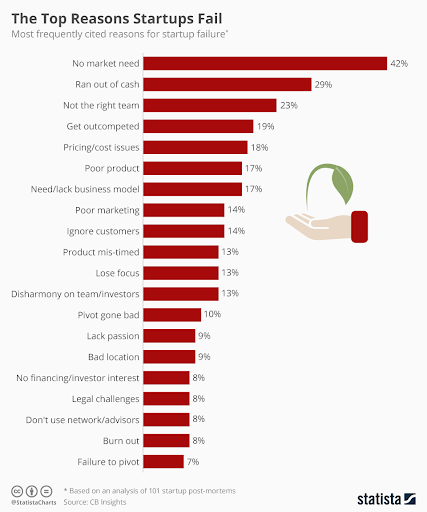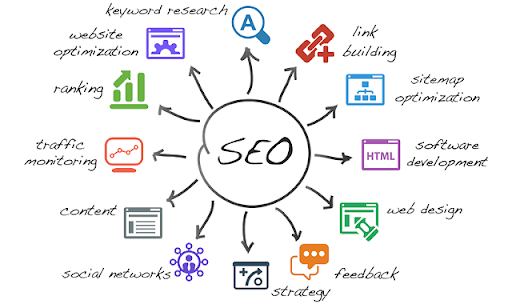Bring In The Nuts And Bolts Of Your Imaginative Ideas | Olive Street Design Will Morph It Into A Unique Business Design
Source: Forbes
More than 500 million businesses were registered in the US in 2021. According to Investopedia, about 75% of businesses fail by reaching their 10th anniversary. Only 25% of businesses can make it up to 15 years or more.
But what is the reason behind their failure? According to Statista, there are several factors that cause a business collapse.

More importantly, if you can have someone who could guide you through and help you assess your business along with providing some major solutions, it will be great. Having firm support can save you a lot of money and find suitable solutions for your business in order to bring stability and consistency.
Turn Your Ideas Into Reality
Once you have analyzed your product or services and structured it, the most important thing to do is the right marketing. If you can crack marketing , you will be able to grow your business to new heights. In this digital era, we need to be more upfront and technology savvy to leverage tools and digital opportunities for marketing our products.

Source: Pexels
Olive Street Design is an amazing partner that can help you grow your business with its tremendous marketing experience. An essential step before marketing a product is to analyze it and prepare a specific strategy keeping in mind the product’s needs. The team at Olive Street Design helps you with this and lets your ideas turn into reality.
All You Need To Grow Your Business
What is better than having all your solutions on a single platform that you can trust due to numerous customer reviews . Let’s have a look at some of the brilliant services with which Olive Street Design can help you grow your business to new heights.
Website Designing
The first step towards digitization of a business in order to market their product digitally is having a suitable website. You must have an eye-catching website that can engage customers. Considering the new trends, mobile-first websites with responsive designs can attract visitors along with the search engine bots to increase your brand visibility. Olive Street Design cares for all these factors while developing an enticing web design for you.
Web Hosting & Maintenance
Maintaining a website sometimes becomes hectic and a tough job. You need to keep yourself updated and be careful about the CMS and upgrades. What if you have a wonderful website, but it is down due to maintenance or any other reason. With a 99.99% uptime, Olive Street Design offers the best hosting and maintenance services.
Planning Your Marketing Strategy
Before you start your marketing, it is essential to know some critical factors that can help you achieve your marketing goals. These factors include:
- Identifying the objective of your marketing campaign. It could be to increase your sales, build brand awareness , or boost customer reach.
- Analyzing your target audience. For instance, if you are selling infants’ items, the most suitable audience for you is women.
- Researching the potential of the market. It can provide you with an idea of how much investment should be made.
- Studying about your competitors. How do they work, and what are their marketing strategies. You need to think one step ahead.
- Scrutinizing the correct channels for your brand with respect to your marketing goals and your target audience.
Experts at Olive Street Design evaluate these factors before they start investing your money in marketing.
SEO
As concluded by a report published by Dissertation Assistance UK , “Optimizing your website for the search engine is not everyone’s cup of tea. It’s not that you are not capable of doing it. Yes, you are. But it takes a lot of time, expertise and deep analysis accompanied by numerous tools and reports.”

By performing extensive keyword research, competitor analysis, website optimization, and detailed reporting, experts at Olive Street Designs help your website rank in the search engines. They use tools like AHrefs, Moz, SEMRush, Google Keyword Planner and analyze your website with the help of Google PageSpeed Insights, LightHouse, etc.
Brand Development
Making others remember your brand is not an easy task. It takes years to build a healthy brand reputation, and even more, efforts are required to maintain that reputation. You need to be consistent with your products and marketing in order to build your brand .
Moreover, keep your quality at its best. Above all, keeping consistency in your brand theme is also very critical so that people can remember your brand by name, color, product, or theme. This is what experts at Olive Street Design (OSD) are excellent at.
Content Creation & Videography

Source: Pexels
Having a great team of content creators, the aim is to come up with your requirements all the time, just like cheap essay writing services . The team at OSD focuses on your product/brand and develops a content strategy accordingly.
They always keep you in sync in order to have your words and opinions. They have a wonderful team of photographers and video editors who come up with amazing videos in the sense of tutorials, guides, behind the scenes, etc. These posts and videos can help you engage your audience on different social media platforms .
Meet Your Business Goals
Setting up a business takes a lot of effort and experience as well. You make mistakes and gradually learn from them. However, wouldn’t it be great if you had some experienced team on your back who could help you with all the matters.
Collaborating with Olive Street Design can help you with numerous features and services that can lift your business. They can figure out the challenges you may face while marketing your products and services. They also have digital solutions for all your needs.
Author Bio

Samantha Kaylee is currently working as an Editor At Crowd Writer, where students ask her to write my essay for me . She is always ready to help understudies with their academic and professional careers. Samantha loves to share her experience with the readers. She often blogs at ObjectMe.



















